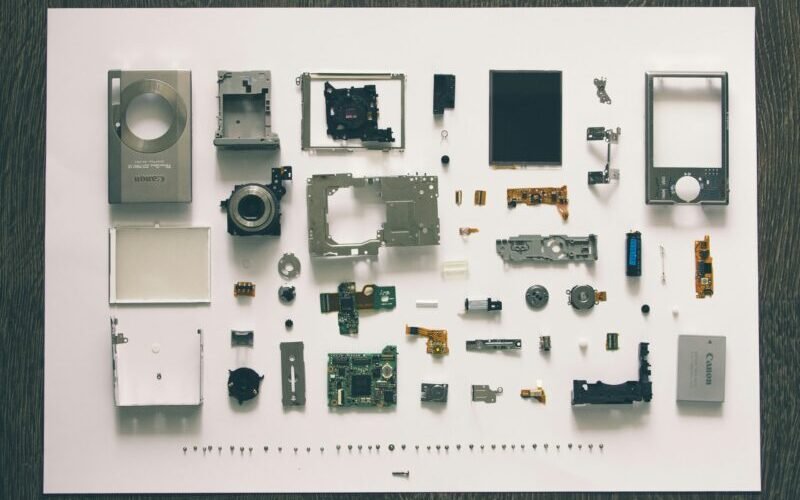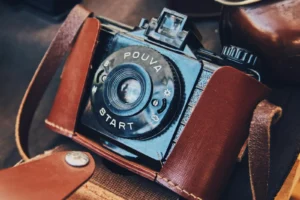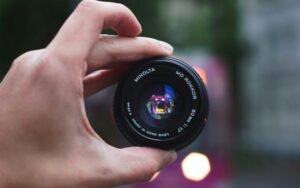Introduction to Camera Parts
Photography is both an art and a science, and at the heart of this medium lies the camera. Understanding camera parts is essential for any photography enthusiast seeking to improve their craft. A camera is more than just a box that captures images; it is a sophisticated device comprised of a multitude of components that work in harmony to create the photographs we cherish. Each part plays a critical role in influencing the final outcome of an image, making it vital for photographers to familiarize themselves with these elements.
The primary components of a camera include the lens, sensor, shutter, and viewfinder, each serving a distinct function. The lens is responsible for focusing light onto the sensor, which is the medium that converts light into a digital signal. The shutter controls the duration of exposure, determining how much light reaches the sensor during a single photograph. Meanwhile, the viewfinder allows photographers to compose their shot before capturing the moment. Understanding these parts enables photographers to make informed decisions while shooting, whether adjusting settings or choosing the right gear for specific conditions.
Delving deeper into the workings of a camera unveils a fascinating world of technology and craftsmanship. From the materials used in the lens to the design of the sensor, every detail contributes to the quality of captured images. As technology has advanced, so too have the intricacies of camera design, resulting in more compact and powerful devices accessible to enthusiasts at all levels. Whether one uses a DSLR, mirrorless camera, or even a smartphone, knowledge of camera parts elevates the photographic experience and fosters a greater appreciation for this timeless art form.
The Lens: The Eye of the Camera
The lens is undoubtedly one of the most critical components of a camera, playing a pivotal role in determining the clarity and quality of the images captured. Essentially, the lens acts as the eye of the camera, gathering and focusing light onto the sensor or film, which in turn registers the photograph. Different types of lenses are designed to achieve various photographic effects, making them indispensable tools for photographers.
One of the primary types of lenses is the wide-angle lens, which typically has a focal length ranging from 10mm to 35mm. This type of lens allows photographers to capture a broader field of view, making it ideal for landscapes or architecture. The ability to fit more into the frame makes wide-angle lenses particularly useful for expansive scenes. Conversely, telephoto lenses, with focal lengths starting from 70mm and extending to over 300mm, are engineered for capturing distant subjects. These lenses excel in bringing far-off details into sharp focus, which is beneficial for wildlife photography or sports events.
Additionally, prime lenses, characterized by a fixed focal length, are also prominent in the domain of photography. While they may limit the range of compositions without physically moving, they often deliver superior image quality and wider apertures compared to zoom lenses. The larger aperture of a prime lens allows for better performance in low-light conditions and can facilitate a shallower depth of field, resulting in beautifully blurred backgrounds that isolate the subject.
Key specifications of a lens, including focal length and aperture, profoundly impact photographic results. The focal length determines the degree of zoom and perspective in the image, while aperture influences the exposure and depth of field, determining how much light enters the camera. Understanding these characteristics and how lens construction affects light quality is essential for mastering photography.
Image Sensor: Capturing Light
The image sensor is a crucial component of digital cameras, playing a vital role in how images are captured and processed. Essentially, it is responsible for converting incoming light into electronic signals, which are then processed to create a visible image. There are two main types of image sensors used in photography: Charge-Coupled Devices (CCD) and Complementary Metal-Oxide-Semiconductor (CMOS) sensors. Each has its own unique characteristics, advantages, and disadvantages that affect image quality and performance.
CCD sensors are known for their excellent image quality, producing less noise and providing greater sensitivity in low-light conditions. This makes them a favored choice among professional photographers, particularly in scenarios where image detail is paramount. However, they tend to consume more power and are generally more expensive to produce than their CMOS counterparts.
On the other hand, CMOS sensors have gained popularity due to their lower production costs and energy efficiency. They allow for faster readout speeds, which can be beneficial for capturing high-speed action. While historically they had poorer image quality compared to CCD sensors, advancements in technology have significantly improved their performance, making them suitable for a wide range of photography applications.
Another important aspect to consider when examining image sensors is their size. The physical dimensions of the sensor can significantly impact image quality. Larger sensors typically capture more light, leading to better performance in low-light environments and improved depth of field effects. Popular sensor sizes include full-frame, APS-C, and micro four-thirds formats, each offering different benefits and drawbacks depending on the desired application and style of photography.
Understanding the role of the image sensor and its various types can help photography enthusiasts make informed decisions when selecting a camera. Ultimately, the choice of sensor and its specifications will influence the quality and creativity of captured images.
Shutter Mechanism: Controlling Exposure
The shutter mechanism is a vital component within a camera that governs exposure time, thus determining how long light strikes the sensor, and ultimately shaping the captured image. This mechanism can be broadly categorized into two types: mechanical and electronic shutters. Each type has its own operational methodologies and advantages, contributing distinctively to photography.
A mechanical shutter functions by physically opening and closing a set of blades or curtains to permit light to hit the imaging sensor or film. This process is key in defining shutter speed, which is the duration the shutter remains open. Faster shutter speeds, typically ranging from 1/4000th of a second to 1/1000th of a second, are employed to freeze motion, making them ideal for action shots or bright conditions. Conversely, slower shutter speeds, such as 1 second to 1/30th of a second, capture motion blur, providing artistic effects or compensating for lower light situations.
On the other hand, electronic shutters capture images by using a sensor’s readout capabilities rather than a physical mechanism. This system can achieve near-instantaneous exposure times and eliminate the sound associated with mechanical shutters. However, this method may introduce issues such as rolling shutter effect, where moving subjects can appear distorted due to the sequential scanning of the sensor.
The significance of shutter speed cannot be overstated, as it directly affects not just exposure but also the aesthetic quality of the photograph. A quick shutter speed can enhance crispness in fast-moving scenes, while slower speeds can add dynamism through motion blur. Overall, understanding the shutter mechanism, including its types and the implications of shutter speed, is crucial for photography enthusiasts aiming to master their craft and efficiently control exposure in various shooting conditions.
Camera Body: The Heart of the Camera
The camera body serves as the central unit where all essential components converge, playing a pivotal role in photography. Constructed from various materials, the camera body can significantly influence both the durability and functionality of the device. Common materials include plastic, aluminum, and magnesium alloys, which provide a balance between weight and sturdiness. Higher-end models often utilize magnesium alloy for added resilience, making them suitable for demanding conditions.
Ergonomic design is another critical aspect of the camera body. The layout of buttons, dials, and grips can drastically enhance user experience, especially during extended shooting sessions. A well-designed camera body allows photographers to operate the device intuitively, minimizing the need to divert focus from their subject. It is essential to consider aspects such as the camera’s weight, grip comfort, and balance when selecting a model that fits one’s shooting style. For instance, a heavier DSLR may provide stability for long lenses, while a lighter mirrorless camera may be preferred for travel due to its portability.
Another factor to consider is the distinction among various camera types. Digital Single-Lens Reflex (DSLR) cameras offer an optical viewfinder and a robust body, ideal for professionals who seek tactile control over their photography. In contrast, mirrorless cameras eliminate the need for a mirror box, yielding a more compact design without compromising performance. Compact cameras, although smaller and simpler, still house vital functions, catering to those who prioritize convenience. Ultimately, the choice of camera body influences not only the quality of photographs but also the overall photographic experience.
Viewfinder and LCD Screen: Composing the Shot
In the realm of photography, the viewfinder and LCD screen serve as crucial tools for composing and capturing images effectively. Each tool presents unique advantages in the pursuit of creating visually compelling photographs. Understanding the differences between optical viewfinders (OVF) and electronic viewfinders (EVF) enhances one’s ability to choose the right camera type for specific photographic needs.
The optical viewfinder is a traditional component found in many cameras, primarily those of a DSLR variety. It works by allowing light to pass directly through the lens, providing a real-time view of the scene. Photographers often find that OVFs afford a sense of immediacy and clarity, presenting an unobstructed perspective without any electronic delay. This type of viewfinder is advantageous for capturing fast-moving subjects in bright light, as it does not interfere with the natural light entering the lens.
On the other hand, electronic viewfinders have gained popularity, especially in mirrorless cameras. EVFs display a digital representation of the scene using a small screen, which can provide several benefits. They allow photographers to preview exposure, white balance adjustments, and depth of field in real time. This functionality enables more precise image composition, making it easier to determine how various settings will impact the final photograph. The versatility of EVFs caters well to both creative experimentation and critical focusing in complex lighting conditions.
Complementing these viewfinders is the LCD screen, an essential tool found on most modern cameras. It serves multiple purposes, including framing shots from awkward angles, assisting in menu navigation, and displaying image playback for immediate review. The LCD is particularly beneficial in outdoor settings where overhead sunlight may make it challenging to see through an optical viewfinder.
Ultimately, both the viewfinder and LCD screen empower photographers to compose their shots meticulously, whether through direct observation or electronic means. Understanding their respective strengths will enhance photographers’ capabilities and enrich their visual storytelling.
Flash and Lighting Accessories: Enhancing Photography
Photography relies heavily on lighting to produce visually striking images. While natural light plays a significant role, artificial lighting techniques through flash units and lighting accessories can dramatically enhance photographic outcomes. Understanding the differences between built-in and external flash units is crucial for any photography enthusiast.
Built-in flash units, typically found in most cameras, are convenient for quick shots. They provide automatic exposure adjustment, which can be beneficial for beginners. However, the limitations of built-in flashes include a narrow range and harsh lighting that can lead to overexposed or unflattering results. In contrast, external flash units offer greater versatility, allowing photographers to manipulate lighting angles, intensity, and diffusion. The use of external flashes, such as speedlights or shoe-mounted flashes, enables creative lighting setups that can transform the mood and tone of an image.
Beyond flash units, various lighting accessories can profoundly influence the final outcome of a photograph. Softboxes, for instance, diffuse light to achieve softer and more evenly distributed illumination, reducing harsh shadows and highlights. Reflectors also serve a crucial role in enhancing exposure by redirecting available light onto the subject, making them an invaluable tool for portrait photography. Using colored gels can further enhance creativity by adding vibrant hues to lighting, contributing to distinct styles.
When employing artificial light, a few tips can optimize the overall effect. Adjust the flash output according to the environment, and always consider the subject’s distance from the light source. Experimenting with different setups, such as bouncing light off walls or incorporating multiple light sources, can significantly affect depth and dimension in photographs. Understanding and utilizing various flash and lighting accessories ensure a comprehensive approach to capturing exceptional images.
Storage Media: Keeping Your Memories Safe
In digital photography, the significance of storage media cannot be overstated. It acts as the lifeline for your captured images, ensuring that your memories are securely stored and easily accessible. Among the most common types of storage media used in cameras are Secure Digital (SD) cards and CompactFlash (CF) cards. Each of these options offers distinct advantages depending on the needs of the photographer.
SD cards are widely utilized in many consumer cameras and smartphones. They come in different classes, which dictate their speed and performance. For instance, a Class 10 SD card guarantees a minimum write speed of 10 MB/s, making it suitable for high-resolution photography and video recording. In contrast, CF cards are typically favored by professional photographers due to their higher storage capacities and faster read/write speeds, which can be essential when shooting in burst mode or capturing 4K videos.
When selecting the appropriate memory card for your photographic endeavors, consider both the storage capacity and speed. This is particularly relevant if you frequently shoot in RAW format or record high-definition video, both of which demand more storage and faster write speeds. As a general rule, opt for a card with at least 64GB of storage for advanced photography and check the speed rating to ensure it meets your shooting requirements.
Moreover, effective management and maintenance of your storage media are paramount. Regularly backing up your images to external hard drives or cloud storage can prevent potential data loss. Additionally, avoiding filling your cards to maximum capacity and formatting them in-camera can prolong their lifespan. By adhering to these best practices, photographers can rest assured that their treasured memories remain safe and secure, allowing for a more enjoyable photography experience.
Maintenance and Care for Camera Parts
Maintaining and caring for camera parts is crucial for photography enthusiasts who want to ensure the longevity and optimal performance of their equipment. Regular cleaning and proper handling can significantly extend the life of your camera and its components, allowing for more breathtaking photography experiences.
One of the most important aspects of camera maintenance is the cleaning of lenses. Dust, fingerprints, and smudges can accumulate on the lens surface, affecting image quality. To clean your lenses effectively, use a microfiber cloth specifically designed for optics. Begin by gently removing any loose dust with a blower or brush. Then, use the cloth in circular motions, slightly dampened with a lens cleaning solution, to eliminate stubborn marks. Care should be taken to avoid excessive pressure, which could potentially scratch the lens.
Another critical element involves safeguarding delicate components, such as the camera body and internal mechanisms. Always store your camera in a protective case when not in use, and be mindful of environmental factors. Avoid exposing your gear to extreme temperatures, humidity, or direct sunlight, as these elements can cause significant damage over time. If the camera is regularly used in harsh conditions, consider utilizing weather-sealed models or protective covers to safeguard against moisture and dust.
Furthermore, regular servicing is vital for ensuring all camera parts function harmoniously. Schedule professional check-ups or maintenance at least once a year, especially if the camera experiences frequent usage or exposure to challenging environments. This proactive approach allows for the detection and correction of potential issues, maintaining performance and safety.
In conclusion, understanding the maintenance and care of camera parts is essential for anyone looking to preserve their photographic equipment. By implementing these cleaning tips, safeguarding delicate components, and prioritizing regular servicing, photography enthusiasts can keep their cameras in optimal condition, ultimately enhancing their creative pursuits.






